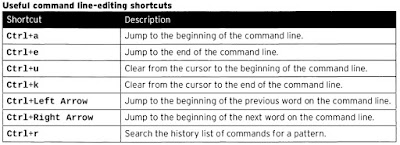Chapter 1. Accessing the Command Line.
- The bash shell
A command line is a text-based interface.
Shell prompt :
regular user : $
superuser(root) : #
- Virtual consoles
Users access the bash shell through a terminal.
Another way to access a shell is from a virtual console.
With a graphical environment running,access a text login prompt
on a virtual console by holding Ctrl+Alt and pressing a function
key (F2 through F6). Press Ctrl+Alt+F1to return to the first virtual
console and the graphical desktop.
- Shell basics : Command -[Options] Arguments
For example : usermod -L morgan
指令繁多,要善用 --help 查詢參數
- The GNOME desktop environment
圖形化介面操作,有些快速鍵與視窗介面配置
和Windows的設置不同,須熟悉
另外,要會登出、登入、切換使用者、變更密
碼、鎖定、重新啟動、關機等基本操作
GNOME Help
# yelp
GNOME Help : Getting Started with GNOME
# yelp help:gnome -help/getting -started
- Basic command syntax
※ 要善用 Tab 鍵的自動完成(Tab completion)
# date
Sat Apr 5 08 : 13 : 50 PDT 2014
列出本機當前日期與時間
# date +%R
08 : 13
以24小時制格式,列出本機當前時間的時與分
# date +%x
04/05/2014
以mm/dd/yy的格式,列出本機當前日期的月/日/年
# passwd
修改當前登入帳號的密碼
# file <filename>
顯示 <filename> 的檔案類型
# head -n <Number> <filename>
顯示 <filename> 檔案前 <Number> 行的內容
# tail -n <Number> <filename>
顯示 <filename> 檔案後 <Number> 行的內容
# wc [Options] <filename>
-l 顯示 <filename> 的行數
-w 顯示 <filename> 的字數
-c 顯示 <filename> 的 byte 數
# history
顯示使用者曾經輸入過的指令
!number 可直接執行該編號的指令
!string 可執行最近一次所執行過的指令,其開頭為指定的字符串
- Editing the command line

